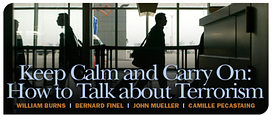Lead Essay
In his lead essay, William Burns argues that national discussion of terrorism can take one of two forms: It may be reflexive and fear-driven, or scientific and confident. He expresses hope that the new administration will choose the latter: In recent years, abundant research has been conducted on the social psychology of risk, and that of terrorist risk in particular. Moreover, the transition to a new administration offers an opportunity to change the official tone of public discourse about terrorism, and to employ many of the insights now being produced in social psychology. Burns outlines some of the major findings and describes how they might be applied to public counterterrorism policy.
Response Essays
In his response to William Burns, Bernard Finel argues that “the fear of fear” can also be exaggerated: Panics come and go, and U.S. institutions that support liberty and limited government are more robust than we often tend to think. Finel also expresses skepticism about the power of messaging, which he terms a “blunt instrument.” Although terrorism has been used, regrettably, as a tool of partisan politics, the right response is simply to condemn this approach and leave it behind. A better message about terrorism won’t do much to combat public fear, in part because the U.S. government is just one voice among many, and fearmongers are still out there regardless of what it might say. Finel argues that a better strategy for actually ending terrorism might include U.S. disengagement from the Middle East, nuclear nonproliferation, and energy independence, among other measures, and that these, too, are likely to ease public fears.
In his response essay, John Mueller assigns some (astonishingly small) numbers to the likelihood of being killed by terrorists. He also notes that the dangers of overreaction and fear are indeed quite great, often greater than the dangers that prompted the fear in the first place. Irrational fears lead to lost civil liberties, useless or near-useless government agencies and programs, and a variety of anxiety-related public health problems. Each of these may well be worse, in terms of hurting our quality of life, than whatever terrorism they were designed to stop.
Camille Pecastaing argues that although the United States had faced terrorism before September 11, something about that particular attack clearly induced more widespread fear. Was it the magnitude of the attack? The foreignness of the attackers? The response of the Bush administration? A combination of all of these? Our answers, about which there is no consensus, may prove important in responding to future attacks.
He also observes two particularities about the response to September 11: First, there was overwhelming momentum toward hysteria. And second, that momentum dissipated very quickly. Although we are still paying the price for this overreaction today, we at least inhabit a political world where the costs can be assessed soberly and where we can attempt to craft better counterterrorism strategies for the future.

